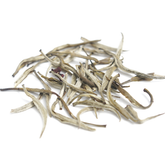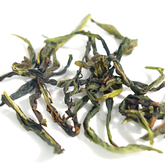What Is The Tea Used In Chinese Restaurants|NPTEA
Recommended purchase:
Typically, tea lovers in China prefer natural teas, meaning those without added flavors or colorings. With a vast array of tea types across the six major categories, different regions may serve different varieties. If you find a tea you particularly enjoy, don’t hesitate to ask the server for more details. Here are some well-known teas from China’s six major tea categories:
Green Tea
Green tea, with famous varieties like Biluochun (Green Snail Spring) and green tea Xihu Longjing (West Lake Dragon Well), is commonly served in restaurants across Zhejiang Province, China. Its straightforward brewing method—just steep the leaves directly in a glass cup—makes it a popular choice. The tea broth first hits your tongue with a fresh, lively flavor, then shifts to a slight bitterness, but leaves a lasting sweet aftertaste.
Thanks to its light and delicate taste, green tea is often paired with mild dishes like seafood or fresh vegetables. It effectively cuts through greasiness without overpowering the food’s natural flavors. Note that not everyone loves green tea’s grassy bitterness, but its health benefits—packed with antioxidants like catechins (tea polyphenols)—make it a smart choice. Chinese people typically enjoy green tea most in spring when the leaves are at their peak flavor. You’ll find green tea served more often in northern Chinese restaurants, since northerners prefer the simplicity of glass cup brewing over the elaborate Gongfu tea sets used in southern traditions.
Note that not everyone loves green tea’s grassy bitterness, but its health benefits—packed with antioxidants like catechins (tea polyphenols)—make it a smart choice. Chinese people typically enjoy green tea most in spring when the leaves are at their peak flavor. You’ll find green tea served more often in northern Chinese restaurants, since northerners prefer the simplicity of glass cup brewing over the elaborate Gongfu tea sets used in southern traditions.
White Tea
White tea is commonly served in restaurants across southern China, especially in Fujian Province, where the finest white teas are produced. As the least processed among traditional Chinese teas, white tea undergoes minimal fermentation and is primarily grown in Fuding and Zhenghe (Fujian).
Its defining technique is “natural withering”—fresh leaves are neither stir-fried nor rolled after picking. Instead, they’re sun-dried or air-cured indoors to slowly evaporate moisture, allowing slight fermentation while preserving the silvery-white fuzz (“baihao”) on the leaves. This ultra-simple process gives white tea its pure, “untouched wilderness” flavor. New white tea brews into a pale yellow, crystal-clear liquor with a sweet, mellow taste and subtle floral or grassy notes. Aged white tea such as Shoumei (stored over 3 years) develops a richer profile, with pronounced date-like or herbal aromas and an amber-colored brew. Brew it with 90°C–95°C (194°F–203°F) water, and note its high re-steepability—some even boil the leaves repeatedly. Rich in amino acids and flavonoids, white tea is believed by the Chinese to have antiviral properties, making it a go-to choice for soothing sore throats.
New white tea brews into a pale yellow, crystal-clear liquor with a sweet, mellow taste and subtle floral or grassy notes. Aged white tea such as Shoumei (stored over 3 years) develops a richer profile, with pronounced date-like or herbal aromas and an amber-colored brew. Brew it with 90°C–95°C (194°F–203°F) water, and note its high re-steepability—some even boil the leaves repeatedly. Rich in amino acids and flavonoids, white tea is believed by the Chinese to have antiviral properties, making it a go-to choice for soothing sore throats.
Black Tea
Black tea is another staple in Chinese restaurants. Famous varieties include Fujian’s Lapsang Souchong ( Zhengshan Xiaozhong ), Anhui’s Keemun (Qimen Hongcha), and Yunnan’s Dianhong. As a fully oxidized tea, black tea brews into a deep reddish-orange liquor with a robust, malty sweetness and caramel or honey notes, staying smooth even after prolonged steeping. Its high oxidation level gives black tea a milder, less bitter taste than green tea, pairing perfectly with greasy dishes like hotpot. Restaurants often use inexpensive black tea crumbs for bulk brewing—they’re cost-effective, brew strong flavors quickly, and work well as a base for milk tea. Keemun black tea, known for its balanced profile, is a year-round favorite, especially popular in winter.
Its high oxidation level gives black tea a milder, less bitter taste than green tea, pairing perfectly with greasy dishes like hotpot. Restaurants often use inexpensive black tea crumbs for bulk brewing—they’re cost-effective, brew strong flavors quickly, and work well as a base for milk tea. Keemun black tea, known for its balanced profile, is a year-round favorite, especially popular in winter.
Pu’er Tea
Pu’er tea comes in raw (sheng) and ripe (shou) varieties, though most restaurants serve the latter. Ripe pu’er, a post-fermented tea, is particularly popular in Guangdong Province’s Cantonese restaurants. Its mellow nature produces a dark red, translucent brew with earthy or woody notes and a silky texture. It’s highly effective at cutting through greasy or spicy foods (like meat-heavy meals), aiding digestion and easing stomach discomfort. Low-end restaurants often use broken crumbs from compressed tea cakes or low-grade loose leaves—they’re cheap, re-steepable (5–6 times per pot), and ideal for long dining sessions. The fermentation process also generates probiotics that promote gut health. High-end Cantonese eateries may offer aged pu’er, prized for its smoother, sweeter liquor.
Low-end restaurants often use broken crumbs from compressed tea cakes or low-grade loose leaves—they’re cheap, re-steepable (5–6 times per pot), and ideal for long dining sessions. The fermentation process also generates probiotics that promote gut health. High-end Cantonese eateries may offer aged pu’er, prized for its smoother, sweeter liquor.
Jasmine Flower Tea
Jasmine green tea, typically made with a green tea base infused with fresh jasmine blossoms, is a signature offering in northern Chinese restaurants. Its intense floral aroma and refreshing, subtly sweet taste make it versatile—it can stand alone as a palate cleanser or complement dishes without overshadowing their flavors. It’s especially great with fried foods like spring rolls or crispy duck. The volatile aromatic compounds in jasmine flowers stimulate appetite and neutralize greasiness, making it a perfect match for rich dishes like braised pork or Peking duck. Upscale restaurants might use premium Silver Needle jasmine tea (茉莉银针), whose bright, sweet liquor pairs elegantly with delicate dishes like steamed fish or white-cut chicken.
The volatile aromatic compounds in jasmine flowers stimulate appetite and neutralize greasiness, making it a perfect match for rich dishes like braised pork or Peking duck. Upscale restaurants might use premium Silver Needle jasmine tea (茉莉银针), whose bright, sweet liquor pairs elegantly with delicate dishes like steamed fish or white-cut chicken.
Common Teas in Chinese Restaurants
China has a wide variety of teas and a large range of tea-growing regions. Unlike some restaurants that serve a specific type of tea, Chinese restaurants often offer different teas depending on their location. Many restaurants serve tea from nearby tea-producing areas. For example, in Zhejiang province, Longjing (Dragon Well) green tea is a popular choice, while in Yunnan, Pu-erh tea is more common.
Tea preferences are also influenced by regional drinking habits. In southern China, like Guangdong province, Pu-erh tea is favored. In northern cities like Beijing, green tea and jasmine tea are more popular. The table below provides an overview of the common types of tea served in Chinese restaurants across different regions.
| Region | Key Provinces | Common Teas | Popular in Restaurants | Why? |
|---|---|---|---|---|
| Southern China | Guangdong, Fujian | Pu’er, White Tea, Black Tea | Ripe Pu’er, Fuding White Tea, Lapsang Souchong | Humid climate; Pu’er aids digestion. Fujian is the birthplace of white tea. |
| Eastern China | Zhejiang, Jiangsu, Anhui | Green Tea, Black Tea | Dragon Well (Longjing), Biluochun, Keemun Black Tea | Local famous teas; green tea pairs with light dishes; black tea balances greasy foods. |
| Northern China | Beijing, Shandong | Jasmine Tea, Green Tea | Jasmine Tea, Basic Green Tea | Hard water in the north; jasmine’s strong aroma cuts through hard water taste. Quick to brew. |
| Southwestern China | Yunnan | Pu’er, Dianhong Black Tea | Ripe Pu’er, Yunnan Black Tea (Dianhong) | Yunnan is the home of Pu’er; bold black teas hold up to spicy local dishes. |
| Fujian Region | Fujian (Fuding, Zhenghe) | White Tea, Black Tea | Silver Needle White Tea, Shou Mei, Lapsang Souchong | Unique white tea processing; smoky black teas pair well with seafood. |
Conclusion Of Tea Served In Chinese Restaurants
In China’s rich and diverse range of tea varieties and flavors, if you encounter a chinese tea you love at a restaurant but aren’t sure of its tea name, feel free to ask the staff; they will provide you with accurate and detailed information. Since China is so vast, the chinese tea served can vary greatly between different regions and restaurants.
In Chinese restaurants in the U.S. and some European countries, the most commonly served tea is jasmine green tea.
It has a light, delicate flavor that most people find easy to enjoy. Compared to pu-erh or oolong tea, jasmine tea’s floral aroma is more appealing, especially to Western customers.
SEE MORE ABOUT TEA
If you are a beginner about Chinese tea:
Basic-Guide-to-Chinese-Tea
If you have questions about selecting tea:
Learn-more-about-chinese-tea
If you have questions about the benefits of tea:
Health-benefits-of-chinese-tea
If you have questions about brewing tea:
How-to-brew-loose-leaf-tea









